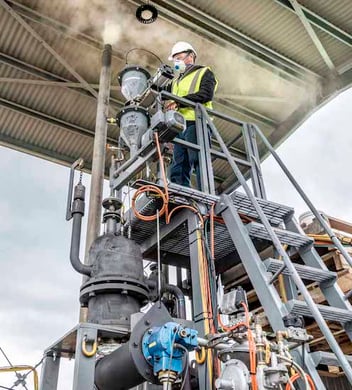Training centre leads advances in biosolids treatment and reuse

As the Australian water sector continues to strive toward transitioning to a circular economy, advances in biosolids treatment technologies and application options will be key to ensuring wastewater streams are effectively transformed into beneficial resources.
One collaborative and interdisciplinary five-year program of research, the ARC Training Centre for Transformation of Australia’s Biosolids Resource, is leading the way with an impressive array of university and industry-partnered projects.
Now about half-way through its program of research, the training centre is working to deliver technological solutions, to train the next generation of biosolids practitioners in transformational approaches, and to guide best practice in the biosolids sector.
The program involves four university partners – the University of Queensland, RMIT, UNSW and the University of Western Australia – as well as 27 industry partners across Australia. There is currently a cohort of 50 PhD students and post-docs throughout the training centre.
Director of the University of Queensland’s Australian Centre for Water and Environmental Biotechnology, Professor Damien Batstone said biosolids represent a very significant stream of resources, one which can and should be managed and utilised more effectively.
“An inevitable consequence of human activity, biosolids have always been regarded as a major source of nutrients and a potential public health hazard. We’ve gotten a lot better at managing it, but there is still more to do,” he said.
“Biosolids represent a very large stream that’s very costly to manage. Around 50% of the cost of wastewater treatment is related to biosolids management. Often, it’s the cost of moving the stuff around.
“We want to find ways to treat and use biosolids more effectively and beneficially because it is such a large material stream. It’s a source of uncontested carbon, nutrients and water. It also represents a very large stream of carbon that was once CO2 that is now available for us to use.”
Batstone said efforts to achieve more effective and efficient reuse of the resources within the biosolids stream can also help to inform waste-to-resource initiatives in other sectors, too.
“This work offers a model for other waste-to-resource initiatives, as well. For example, food and garden organics, municipal waste and animal byproducts,” he said.
“The technology for biosolids is common to those streams, too, but biosolids transformation is generally a leader in this area because we have always had to treat biosolids. Municipal biosolids are something we have always had to deal with.”
Reuse hurdles
Batstone said there are 10 sub-projects currently running within the centre, but all are connected to three key themes, or challenge areas.
“First, we are looking at new technologies for biosolids treatment. Our second theme is products and future market directions, looking at what kinds of things we can make from biosolids,” he said.
“And the third is frameworks and license to operate. This involves things like odour control, but it also involves community participation and micropollutant management, as well.”
In terms of the challenges facing the biosolids resource sector, Batstone said the cost of moving biosolids dominates, including the issue of removing water: “The technical challenge of removing water efficiently has always dominated the cost of moving biosolids”.
“So technically, dewatering is the key issue. Most of the projects under our technology theme are focused on the fundamentals of being able to remove water effectively or being able to treat the biosolids so that you can remove the water effectively,” he said.
“But there is also the technical challenge of minimising the amount of organic material by converting most of it to energy before it even leaves the treatment plant. Another challenge is efficiently digesting biosolids to methane or destroying it to thermal energy.”
Under theme two of the research program, identifying suitable products is a fast-growing focus, Batstone said.
“At the moment we don’t use biosolids super efficiently because we transport it long distances. We are looking for markets that might be closer, but also creating blended products that are safer, more useful or more widely applicable,” he said.
“There are also other technological options to use biosolids-derived products, things like wastewater treatment chars, or activated carbon substitutes, or absorbents.”
While contaminant management has always been a strong focus within biosolids treatment, Batstone said emerging contaminants are posing new challenges that need close attention.
“We’ve known how to remove pathogens effectively in biosolids for hundreds of years. In the last 30 years, we have had a very effective framework set up for managing pathogens. We have managed metal contaminants quite effectively, too,” he said.
“But now we have a number of emerging contaminants, like PFAS, pharmaceuticals and microplastics. How do we manage them out of the influent, or identify and manage their impact on end use? What level is acceptable under a risk-based approach?”
Lasting benefits
Batstone said that, while the five-year program is not yet complete, there are already significant benefits being produced by the centre.
“We have generated a lot of capacity. There are a lot of new methods available within the universities involved, which are now available to industry partners, as well,” he said.
“We already have industry partners using technical input from the training centre on very large projects.
“We have identified a number of new avenues within biosolids assessment. We have developed a fingerprinting technique that gives an identification of how materials are likely to behave through different treatment trains.”
Batstone said the thermal technologies team at RMIT has started implementing a new suite of pyrolysis technologies under joint projects with water utilities – an ongoing project with quite a lot of promise in terms of trying to optimise things like energy efficiency.
“We have also been developing a microbial community assessment looking at some of the underlying causes of digester foaming, which is a problem that commonly arises,” he said.
“Within the new products area, we have done quite a lot of work on developing biosolids blends for custom feritilsers. We are also doing work on identifying the markets for biosolids char.”
Importantly, the projects all have continuous industry involvement, Bastone said, and collectively the centre has developed a number of tools already available for use.
“We have a wastewater plant simulator to trial different biosolids treatment trains. It’s a virtual simulator. We can enter a scenario and test how different treatment processes might result in different outcomes,” he said.
“But one of the biggest products being nurtured by the centre is our students and post-docs.
Water Research Australia is our training partner, they manage placements. All our students do a six-month placement within industry as part of their PhD journey.
“It’s expected that the vast majority of our PhD students will end up in industry rather than in academia. So we are preparing the next generation of biosolids experts with cutting-edge technology.”


